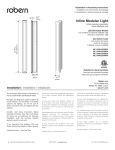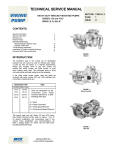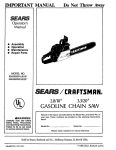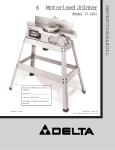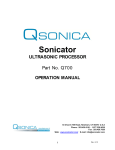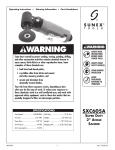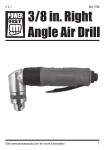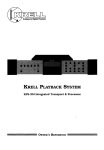Download Clarke CBS-12WB Owner`s manual
Transcript
Clarke WOOD CUTTING 12" BANDSAW MODEL CBS-12WB PART NO. 6460008 OWNERS MANUAL BEFORE USING BE SURE TO REA D THIS MANUAL CONTENTS I. UNPACKINGAND CHECKINGCONTENTS.. . . . . . . . . . . . . . . . . . . . . 2 II. TO KNOW YOUR BAND SAW . . . . . . . . . . . ' . . . . . . . . . . . . . . . . . . . Tension AdjustmentKnob Cover Knobs Blade Guides Tension Lock Knob Guide Bar Lock Knob Table Lock Knobs Bevel Scale On-Off Switch 3 III. ASSEMBLY. . . . . . . . . . . . . . . . . . . . . .--. . . . . . . . . . . . . . . . . . . . . . Installingthe Table 4 Replacingthe Blade. . . . . . . . . . . . . . . . . . . . . . . . . . . . . . . . . . . . . . . Tensioningthe Blade . . . . . . . . . . . . . . . . . . . . . . . . . . . . . . . . . . . . . . Tracking the Blade. . . . . . . . . . . . . . . . . . . . . . . . . . . . . . . . . . . . . . . . Adjustingthe Table Square to Blade 5 7 8 AdjustingUpper Blade Guide Assembly.. . . . . . . . . . . . . . . . . . . . . . . . AdjustingUpper Blade Guides 9 AdjustingUpper Thrust Bearing. . . . . . . . . . . . . . . . . . . . . . . . . . . . . . . 10 AdjustingLower Blade Guide Assembly MountingBand Saw to Workbench. . . . . . . . . . . . . . . . . . . . . . . . . . . . . ClampingBand Saw to Workbench. . . . . . . . . . . . . . . . . . . . . . . . . . . . . IV. SAFETY RULES . . . . . . . . . . . . . . . . . . . . . . . . . . . . . . . . . . . . . . . . V. GROUNDING. . . . . . . . . . . . . . . . . . . . . . . . . . . . . . . . . . . . . . . . . . . VI. BASIC OPERATION& TROUBLESHOOTINGGUIDE. . . . . . . . . . . . . . . . VII. MAINTENANCE.. . . . . . . . . . . . . . . . . . . . . . . . . . . . . . . . . . . . . . . . VIII. TECHNICALD A T A . . . . . . . . . . . . . . . . . . . . . . . . . . . . . . . . . . . . . . IX PARTS LISTING . . . . . . . . . . . . . . . . . . . . . . . . . . . . . . . . . . . . . . . X. PARTS DIAGRAM. . . . . . . . . . . . . . . . . . . . . . . . . . . . . . . . . . . . . . . 11 12 13 1 6 17 2 0 2 1 2 2 24 I. UNPACKING AND CHECKING CONTENTS M. TO KNOW YOUR BAND SAW Unpack carton, check your machine, to see parts listed below: ; A. Basic saw assembly B. Owners Manual C. Saw Table assembly D. Bag Assembly / Containing the following parts: 1. Switch, Key 1. Tension adjusting knob . . . Tightening the knob (clockwise) will increase the tension on the blade. Loosening it (counter clockwise) will decrease the tension. (Tension lock knob must be released). 2. Cover knobs . . . Secure cover to frame by tightening all three (3) cover knobs. 3. Blade Guides . . . Supports the blade and keeps it from twisting during operation. An adjustment is necessary when blades are changed or replaced. 4. Tension lock knob . . . Holds position of the upper wheel which is set by the tension adjusting knob. 5. Guide bar lock knob . . . The upper blade guide assembly should just clear the work-piece while cutting. Always adjust the upper guide assembly and lock the guide bar by tightening the blade guide lock knob before turning on the band saw. 6. Table lock knobs . . . Loosening knobs allows the table to be tilted and tightening knobs locks the table in place. 2. Nut, W ing 1/4-20 3. Screw, Truss Hd. 1/4-20 x 3/4 4. Washer 67 x «i16 x tf6 5. W rench, Hex. "L" 3 MM 7. Tilt (bevel) scale . . . Shows degree table is tilted for bevel cutting. 8. ON-OFF SW ITCH. The On-Off Switch has a locking feature. THIS FEATURE IS INTENDED TO HELP P R E V E N T UNAUTHORIZED AND POSSIBLY HAZARDOUS USE BY CHILDREN AND OTHERS. 6. W rench, Hex. "L" 5 MM 7. Washer 17/64 x 47/64 x 1/16 8. Indicator, Bevel 9. Screw, Pan Cross #10-24 x 3/8" 10. Insert, Table 11. Knob Note: If you find any parts missing or damaged, contact the dealer for exchange replacement. -2- -3- ASSEMBLY Installing The Table Replacing Apply a coat of automobile wax to the table 1. Loosen the guide bar lock knob and position The Blade top and inside surfaces of trunnion that the upper guide assembly approximately one inch above the table and tighten lock knob. slide on frame. 1. Loosen the guide bar lock knob and position the upper guide assembly all of the way up. Tighten lock knob. 2. Loosen the two blade guard mounting screws and remove the blade guard. 2. Locate two knobs and two washers in loose 3. Loosen the guide bar lock knob and position the upper guide assembly approximately two parts bag, and the table assembly. inches above the table as shown and tighten 3. Place table assembly onto band saw frame with the trunnion against mounting rib, in frame. Hold table assembly against the frame and install two (2) table lock knobs and washers as shown through the trunnion slots and tighten. 4. Locate bevel indicator and pan cross hd. screw in loose parts bag. 5. Install bevel indicator and screw as shown the lock knob. 4. Remove table insert, truss head screw, washer and wing nut from the table (See Assembly, "Adjusting the Table"). Replace these parts after the blade is installed, tensioned and tracked. 5. Loosen the two screws in the front of the upper blade guide assembly that secure the blade guides and separate them about 1/8". using a phillips screwdriver. 6. Loosen the two screws in the side of the upper guide assembly and slide guides and, thrust bearing all of the way back. Tighten all screws. -4- -5- 7. Loosen the three (3) cover knobs by turning counterclockwise and remove cover. NOTE: Replace the bandsaw cover after blade is properly installed, tensioned and tracked. Tensioning The Blade NOTE: Your bandsaw can use only 1/4" (6mm) wide blades, 56-1/8" (1425mm) long. A blade is included with this saw. Ensure that, the tension lock knob is tightened before turn on the machine. Tension adjusting knob 8. Loosen the two screws that secure the lower blade guides and separate them about 1/8". Loosen the tension lock knob a little (1/4 of a turn counter-clockwise). 9. Turn the tension adjusting knob clockwise until blade has proper tension. Loosen the screw holding the lower blade guide support and slide support all the way toward the rear of the saw, and retighten all screws. Warning: suddenly carefully length. Turn the wheel by handT clockwise a few e turns and notice if then blade remains in s the approximate center i of the tires. To avoid being scraped should blade uncoil, wear safety goggles and uncoil the blade holding it at arms 10. Place the blad e over the wheels with the teeth pointing downward toward the table as shown. Make sure the blade is in the center of the rubber tires. o n To check blade tension, push thumb against side of blade between lower wheels. Blade should move only slight ly with moderate pressure. Be careful not to over tension blade. Retighten tension lock knob. If too much blade tension has been applied, blades may tend to break more easily and blade life will be shorter. If too little blade tension has been applied, blade may not track easily, may slip on whe els, or will move too easily when checking tension. Note: (1) Tension lock knob must be tighten before mo ving blade. (2) Loosen the tension adjusting knob a little after usage, (to lengthen but ensure that the tension lock knob is still fix on the band saw). -6- -7- the blade's life Tracking The Blade 1. Loosen the Tension Lock Knob (1/4 of a turn counter-clockwise) and turn the tracking adjustment set screw slightly with the hex wrench 3mm (Turning the set screw moves the NOTE: W hen table is tilted to a bevel angle, the lower blade guide support should be lowered to clear the table. After bevel cutting and returning table to zero position, always raise the lower blade guide up to provide maximum support for the blade. tension wheel back and forth.) 2. If the blade moves toward the front of the band saw: Turn the tracking adjustment screw clockwise about 1/4 of a turn, as though you were tightening it. If the blade moves toward the back of the band saw: Turn the tracking adjustment screw counter clockwise about 1/4 of a turn as though you were loosening it. Turn the screw just enough to cause the blade to run in the approximate center of all tires. 3. After adjusting, tighten tension knob and turn upper wheel by hand clockwise a few turns and notice if the blade remains in the approximate center of the tires, Re-adjust if necessary, until blade is tracking properly. Aligning The Table Square To Blade 1. Loosen table lock knobs. Place a square on the table in front of the blade as illustrated. Tilt table up or down to align table 90 degrees to blade (0 degree position) and tighten lock knobs. NOTE: The upper and lower blade guides support the blade and keep it from twisting during operation. An adjustment is necessary when blades are changed, replaced or installed for the first time. Adjusting Upper Blade Guide Assembly * Loosen lower screw on side of upper blade guide assembly and slide assembly forward until the front edge of the blade guides are approximately 1/32" from the GULLET of the saw blade. Tighten screw. Adjusting Upper Blade Guides * Loosen the two screws that lock the upper blade guides and press the two guides evenly against the sides "of the blade but do not pinch the blade. Release the guides and rotate the upper wheel slightly clockwise moving the blade downward. Make sure one guide is not further away from the blade than the other. Tighten both screws. 2. Adjust zero stop set screw using hex wrench (3MM) until set screw just touches frame. Check squareness of blade to table. Make readjustments-if necessary. Set bevel indicator to line up W ith zero. -8- -9- Adjusting Upper Thrust Bearing 1. NOTE: The thrust bearing supports the blade from the rear and will rotate when the blade is pushed against it while you are cutting. As soon as you stop cutting, the bearing should stop rotating. NOTE: After all adjustments have been made, turn the wheel by hand (clockwise) a few turns to check blade travel and clearance. (As diagram shown in paragram "Ten-sioning the blade") Adjusting The Table 1. Replace the blade guard on the upper assembly and tighten screws. 2. Locate the table insert and place it in the opening in the table. Aiiyn slot in the insert with the slot in the table. 2. To adjust, loosen the upper screw on the side of the upper blade guide assembly and slide the bearing forward until it is approximately 1/32" from the back of the blade. Tighten screw. Rotate upper wheel slightly clockwise to check clearance. Re-adjust if necessary. 3. Locate a 1/4 - 20 x 3/4" truss head screw, a f l a t washer, and a 1 / 4 - 2 0 wing nut in loose parts. Insert screw into hole in table top as illustrated. 4. From the underside of the table, install washer and wing nut onto the truss head screw and tighten finger tight. This will keep the table flat and in alignment. 5. Replace the band saw cover. Mounting Band Saw To Workbench If band saw is to be used in a permanent location, it should be fastened securely to a firm supporting surface such as a workbench. Adjusting Lower Blade Guide Assembly * Loosen the screw (as shown) on the side of the lower blade guide assembly and slide assembly forward until bearing is approximately 1/32" from the back of the blade. Blade guides will align with this adjustment. Tighten screw. If mounting to a workbench, holes should be • drilled through supporting surface of the workbench using dimensions illustrated. 1. Each leg should be bolted securely using 3/8" diameter machine screws, lock-washers, and 3/8" hex nuts (not included). 2. Locate and mark the holes where band saw is to be mounted. 3. Drill (4) — <b 11 diameter holes through Adjusting Lower Blade Guides * Loosen the two screws that lock the lower blade guides and press the two guides evenly against the sides of the blade but do not pinch the blade. Release the guides and rotate the upper wheel slightly clockwise moving the blade downward. Make sure one guide is not further away from the blade than the other. Tighten both screws. workbench. 4. Place band saw on workbench aligning holes in feet with holes drilled in workbench. 5. Insert all four 3/8" screws and tighten. NOTE: Front two mounting bolts should be inserted from the bottom with washer and nut on top. An alternate method of mounting is to fasten band saw to a mounting board. The board should be of sufficient size to avoid tipping of saw while in use. Any good grade of plywood or chipboard with a 3/4" minimum thickness is recommended. (Thinner chipboard can break.) -11-10- IV. SAFETY RULES * Follow instructions for mounting to workbench, substituting a board 18" x 24" minimum size and using inch flat head screws, General Safety Rules: 1. KEEP GUARDS IN PLACE and in working order. 2. lock washers, and hex nuts (not included). NOTE: For proper stability, holes must be counter sunk so screw heads are flush with the bottom surface of supporting board. * Securely clamp board to workbench using "C" clamps. REMOVE ADJUSTING KEYS AND W RENCHES. Form habit of checking to see that keys and adjusting wrenches are removed from tool before turning it on. 3. KEEP W ORK AREA CLEAN. Cluttered areas and benches invite accidents. 4. DON'T USE IN DANGEROUS ENVIRONMENT. Don't use power tools in damp or wet location, or expose them to rain. Keep work area well lighted. 5. KEEP C H ILD R EN AW AY. All visitors should be kept safe distance from work area. NOTE: Supporting surface where band saw is mounted should be examined carefully 6. after mounting to insure that no movement during use can result. If any tipping or walking is noted, secure workbench or supporting surface before operating band saw. Clamping Bandsaw To Workbench The Band Saw can be clamped directly to a workbench using two (2) or more "C" MAKE W ORKSHOP CHILD PROOF with padlocks, master switches, or by removing starter keys. 7. DON'T FORCE TOOL. It will do the job better and safer at the rate for which it was designed. 8. USE RIGHT TOOL. Don't force tool or attachment to do a job for which it was not designed. 9. WEAR PROPER APPAREL. No loose clothing, gloves, neckties, rings, bracelets, or other jewelry to get caught in moving parts. Non-slip footwear recommended. W ear protective hair covering to contain long hair. clamps on base of unit. 10. is ALW AYS USE SAFETY GLASSES. Also use face or dust mask if cutting operation is dusty. Everyday eyeglasses only have impact resistant lenses, they are NOT safety glasses. 11. SECURE W ORK. Use clamps or a vise to hold work when practical. It's safer than using your hand and it frees both hands to operate tool. 12. DON'T OVERREACH. Keep proper footing and balance at all times. 13. MAINTAIN TOOLS W ITH CARE. Keep tools sharp and clean for best and safest performance. Follow instructions for lubricating and changing accessories. -12- 14. DISCONNECT TOOLS before servicing; when changing accessories such as blades. 15. REDUCE THE RISK. OF UNINTENTIONAL STARTING. Make sure switch is in off position before plugging in. -13- Special Safety Rules For Band Saws 16. USE RECOMMENDED ACCESSORIES. Consult the owner's manual for recommended accessories. The use of improper accessories may cause risk of injury to persons. 1. Place the blade guard to within approximately 1/8" above the material being cut. 2. Always keep hands and fingers away from the saw blade, especially at the end of a cut. 17. NEVER STAND ON TOOL. Serious injury could occur if the tool is tipped or if the cutting tool is unintentionally contacted. 18. CHECK DAMAGED PARTS. Before further use of the tool, a guard or other part that is damaged should be carefully checked to determine that it will operate properly and perform its intended function-check for alignment of moving parts, binding of moving parts, breakage of parts, mounting, and any other conditions that may affect its operation. A guard or other part that is damaged should be properly repaired or replaced. 19. NEVER LEAVE TOOL RUNNING UNATTENDED. TURN POW ER OFF. Don't leave tool until it comes to a complete stop. 20. DIRECTION OF FEED. Feed work into a blade or cutter against the direction of rotation of the blade or cutter only. 3. Use a push stick or piece of scrap wood to do the pushing and guiding when sawing small pieces which require the fingers to be close to the saw. 4. Stop the machine before removing scrap pieces from the table. 5. Stop the machine if the material is to be backed out of an uncompleted cut. 6. Make all adjustments and set ups with the power off, such as tilting the table, adjusting the saw blade guards and blade guides. 7. Adjust blade tension, upper and lower blade guides, backing bearing and blade tracking correctly. 8. The cover housing must be in place and securely fastened when performing any saw operations. 9. Securely lock all adjustable parts so they cannot loosen while sawing. This will prevent distraction from the sawing operation. 10. When sawing curves, make relief cuts to allow removal of scrap material. This will help prevent undue twisting or binding of the saw blade. The relief cuts are made before starting the curved saw cut. 11. Hold material firmly and feed into the blade at a moderate speed. 12. Be sure to use proper blade size and type according to guide. 13. Do not saw stock that does not have a flat surface, unless a suitable support is used. 14. Keep open flame and high temperature tools such as soldering irons and blow torches away from band saw. 15. Permanently mount your band saw before performing cutting operations. -14- -15- VI. BASIC OPERATION & TROUBLE SHOOTING GUIDE V. GROUNDING GROUNDINGINSTRUCTIONS Basic Operation A band saw is basically a "curve cutting" machine. It flow and reduces the risk of electric shock. This tool has a three-wire electric lead that is also used for straight-line cutting operations such as cross cutting, ripping, mitering, beveling, has a earth conductor and earthed plug. The plug must be used with a matching socket that is properly installed and earthed according to local building codes and ordinances. compound cutting, and resawing. It is not capable of doing inside cutting. Do not modify the three-pin plug, particularly by cutting off the earth pin. Improper This band saw is designed to cut wood and wood like products only. If an electrical problem occurs, earthing provides the path of least resistance for current earthing can cause electric shock. If the plug will not fit a particular socket, have the proper outlet installed by a qualified electrician. The earth conductor within the power cable has either grech insulation or green-andyellow striped insulation. If the cord must be repaired or replaced, ensure that this conductor is properly connected, if you have any questions of doubts about the proper earthing of the tool, check with a qualified electrician. Use only three-wire extension cables that have three-pin earthed plugs and sockets. Repair of replace damaged or worn power cables immediately. For general type scroll cutting, follow the pattern lines by pushing and turning the workpiece at the RIGHT - Planning ahead by turning workpiece for cutting a curve. same time. Do not try to turn the workpiece while engaged in the blade without pushing it; the workpiece could bind or twist the blade. A curve cut is best performed by keeping the pattern line in with the blade while turning the workpiece before the radius of the curve is cut. The blade should cut in the middle of the pattern line (saw kerf) since wood WARNING This appliance must be earthed cutting band saw blades are thin. NOTE: Blade guard is raised for clarity of picture only. IMPORTANT The wires in this mains lead are coloured in accordance with the following code. Green and Yellow Blue -EARTH -NEUTRAL Brown —L I V E As the colours of the flexible cord of this appliance may not correspond with the coloured markings identifying terminals in your plug, proceed as follows: Connect GREEN AND YELLOW coloured core to plug terminal marked letter 'E' Earth Symbol or coloured Green or Green and Yellow. Connect BROW N coloured core to plug terminal marked letter 'L' or coloured Red. Connect BLUE coloured core to plug terminal marked letter 'N' or coloured Black. Sawing 1. Adjust the upper guide assembly to just clear the workpiece. W RONG - Not planning ahead for cutting a curve could bind or twist blade if workpiece is forced. 2. Use both hands while feeding the work into the blade. Hold the workpiece firmly against the table. Use gentle pressure. Do not force the work, but allow the blade to cu t. 3. The smallest diameter circle that can be cut out is determined by the width of the blade. A 1/4" wide blade will cut a minimum diameter of approximately 1-1/2". Relief cuts are made when an intricate curve (too small a radius for a 1/4-inch blade) is to be cut. A relief cut is made by cutting through scrap section of workpiece to curve in pattern line, then carefully backing blade out. Several relief cuts should be made for intricate curves, then follow pattern line as sections are cut off of curve "relieving" blade pressure. NOTE: Blade guard is raised for clarity of picture only. -16- -17- 4. Trouble Shooting Guide Problem Excessive Blade Probable Cause Solution 1 Material loose in vise 1 Clamp work securely 2 Teeth too course for Problem Probable Cause Bad Cuts 5 Guide bearings not adjusted properly. 5 Adjust guide bearings to .002 greater than max. thickness, including weld, of the saw. 6 Inadequate blade tension 6 Increase blade tension a little at a time. 7 Blade guides spaced out too much. 7 Move guides as close to work as possible. 8 Dull Blade 8 Replace blade 9 Blade guide assembly loose 9 Tighten 2 Check Machinist Handbook material. for recommended 3 Incorrect blade tension blade type. 3 Adjust to where blade just does not slip on wheel. Premature Blade 4 Teeth in contact with work before saw is started. 4 Place blade in contact with work after motor is started. 5 Blade rubs on wheel flange. 5 Adjust wheel alignment 6 Misaligned guides 6 Adjust 7 Blade too thick for wheel 7 Use thinner blade 8 Cracking at weld 8 Make longer annealing cycle. 1 Teeth too course 1 Use finer tooth blade 2 Inadequate feed pressure material. 10 Blade guide bearing assembly loose 2 Decrease spring tension on 3 Reduce speed, increase feed Blade is 1 Cut is binding blade Twisting 2 Too much blade tension Unusual Wear 1 Blade guides worn on Side/Back 2 Blade guide bearing of Blade pressure (Scale). Increase feed pressure (Hard Spots). 4 Work hardening of material 4 Increase feed pressure by (especially stainless steel) reducing spring tension. 5 Blade installed backwards I Blade is too coarse blade. Always clamp work tightly in vise. 3 Reduce pressure by increasing spring tension -18- 1 Replace 2 Tighten bracket is loose 1 Use finer tooth blade 2 Too heavy feed; too slow 2 Increase feed pressure and/or feed speed 3 Vibrating work piece 3 Clamp work securely 4 Gullets loading 4 Use coarse tooth blade or brush to remove chips. 1 Blade tension too high 1 Reduce tension on blade 6 Increase tension to proper level. 2 Adjust vise to be square with 3 Feed pressure too great 2 Decrease blade tension 1 Tooth too coarse for work 5 Remove blade, twist inside out 1 Replace with finer blade. 2 Work not square 1 Decrease feed pressure from Blade Motor Running Bad Cuts 11 Retract blade according to operating instructions. Teeth Ripping and reinstall blade. 6 Insufficient blade tension 10 Tighten 11 Blade tracks too far away from wheel flanges side of saw 3 Hard spots or scale in/on Solution side of saw. Too Hot 2 Drive belt tension too high 2 Reduce tension on drive belt 3 Blade is too coarse for work (Pipes especially) 3 Use finer blade 4 Blade is too fine for work (Heavier, soft material) 4 Use coarser blade 5 Gears not aligned properly 6 Gears need lubrication 5 Adjust gears so that worm is in center of gear 6 Check oil bath 7 Idler wheel needs lubrication 7 Oil bearing/shaft on idler wheel -19- VII. MAINTENANCE VIII TECHNICALDATA Lubricate the following components periodically. € 1. Ball bearings. € € € € 2. Bearings of blade guides. 3. Bearing of driven wheel. Bench type, portable weight wood cutting band saw. Motor direct drive, one speed operation. Table can be titled 0°— 45 ° for bevel cut. Sawblade included. Quiet, free maintenance motor. SPECIFICATIONS: Speed ________ 2250 FPM (50 Hz) ______________________ Capacity 12" THROAT/3mm 10" THROAT/5Omm ___________. -20- 3.3/4" (96mm) THICK x 12" (305mm) WIDE_____ Table_________ 11 1/2" x 11 ½” (292 x 292mm) Blade Length____ 56-1/8" (1425mm)______________________ Blade Pitch 6T/INCH_____________________________ Motor_________ 1/5HP 240VQLT/50HZ/1 PHASE_____________ Dimension______ 22-7/16" x 12-13/16" x 23-15/64" (570x325x590mm) N.W. 34.4 Lbs. (15.6 Kgs.) G.W._________ 40.5 Lbs. (18.4 Kgs.) -21- IX. PARTS LISTING Ref. No. Description Part No. Unit Ref. No. Description Part No. Unit 1 Knob MB6A-005 4 37 Shaft guide support MB6A-036 1 2 3 Washer Clamp-guide rod * 1 7/64" x 47/64" x 1/16" MB6-017 7 1 38 Support upper guide MB6-014E 1 39 Support guide MB6-010E 1 4 Screw set hex. * 1/4" x 2 0 U N C - 3/8" 1 5 6 Knob Adjustment label MB6A-005 MB6A -035 1 1 40 41 42 Washer Guard blade Insert blade * 13/ 64"x 1 / 2"x3/ 64" MB6A -020 MB6-028E 1 1 1 7 8 Guide wheel Shaft-upper wheel MB6-018-1 MB6-008 1 1 43 Screw pan cross * No. 10 - 24UNC - 1/2" 2 9 Bearing-ball * 6000Z 4 10 11 Wheel-idler Tire MB6A-028 (0) MB6-021 1 3 44 45 46 Screw pan cross Screw flat cross Screw-truss * 1/4" - 20U N C - 3/4" * 1/4" - 20U N C - 1" * 1/4" - 20U N C - 3/4" 2 3 1 47 Nut wing * 1/4--20UNC 1 12 Ring retaining *S10 2 13 14 Washer Nut hex. * 25/64" x 56/64" x 1/16" * 3/8"-24U NF-L 1 1 48 49 50 Washer Table band saw Screw locking set * 1 7/64" x 5/8" x 1/16" MB6A-011 * 1/4" - 20U N C - 5/8" 1 1 1 15 Blade band saw MB6A-016 1 16 17 Knob Model label MB6A-005 MB6A-034 3 1 51 52 53 Lock washer-internal Nut Lock wahser * No. 10 * 1/4"-20UNC * 5/16" 2 3 5 18 19 * * * Cover frame * * * MB6A-003 1 54 55 Nut Indicator bevel * 5/16-18UNC MB6-025E 1 1 20 21 22 Screw pan cross Ring retaining Bearing ball * No. 10 - 24UN C - 3/8" *d5 * 696ZZ 7 1 1 56 Screw pan cross * N o. 10 - 20U N C - 3/8" 1 57 58 Trunnion Motor MB6-009E (1) MB6A-001M 1 1 23 Shaft upper guide MB6A-019 1 24 25 Guide Shaft-wheel * < * 5 x 14 MB6-016 4 1 59 60 Motor label Cord mounting plate MB6A-010 1 1 26 27 28 Key-switch Switch locking Screw pan cross * 8166 K23 or 8166 K21 * N o.1 0 - 2 4 U N C x 1/4" 1 1 6 29 30 Front cover-switch Frame MB6A-027 MB6A-001 1 1 61 62 63 64 Cord power Foot frame Screw hex. Wrench hex. MB6A - 009 MB6A-002 * 5/16"-18UNC-1%" * 3MM 1 1 4 1 Screw cap hex. Lock washer * 1/4" - 20U N C - 3/4" * 1/4" 4 4 65 66 Wrench hex. Connector wire *5M M 31 32 1 1 33 Support lower guide MB6A-013 1 67 68 Wheel-idler Wheel-drive MB6-006E MB6A-033 (0) 1 1 34 35 Rod guide support Spacer MB6-013E MB6-038 1 2 69 Clamp-cord * SR6N3-4 2 70 Caution laber MB6A-037 1 36 Bearing ball * L - 940ZZ(N BM) 1 -22- (2) MSC1/5 -OOOA Standard Hardware item/may be purchased 23- locally. When ordering service parts. Be sure to mention model number, parts number and ref. number. X. PARTS DIAGRAM Clarke POWER PRODUCTS DEAR CUSTOMER CONGRATULATIONS ON THE PURCHASE OF THIS CLARKE POWER PRODUCT WHICH WE TRUST WILL GIVE YOU LONG AND TROUBLEFREE SERVICE. SHOULD YOU EXPERIENCE ANY DIFFICULTY WITH THE ASSEMBLY OR OPERATION OF THIS PRODUCT, PLEASE CONTACT OUR SERVICE DEPARTMENT AT THE ADDRESS BELOW :CUSTOMER SERVICE DEPARTMENT, CLARKE INTERNATIONAL, DOWNS ROAD, LONDON. E5. TELEPHONE : 071 254 6421














